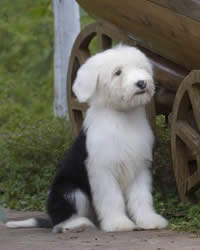Old English Sheepdog Breed Information
Also known as Bobtail or OES
 |
| ||||||||||||||||||||||||||||||||||||||||||||||||||||||||||||||||||||||||||||||||
Old English Sheepdog – Just The Facts
| Do you own this Dog breed?Please tell us about it in the form at the bottom of this page. |
General Description
A teddy bear, a live mop and a comic rolled into one, the Old English Sheepdog is sure to brighten the mood of every home. You will find the dog’s face a darling and its playfulness amusing for its size. This dog breed is the perfect choice for homebodies who could use the protection, entertainment and affection offered by a furry friend.
Origin and History
This breed has been West England’s service dog since the 19th century. Many were used to scare away wolves and herd sheep to the marketplace. By the mid-19th century, the breed assumed the nickname “bobtail.” Tail docking became a norm among working dogs allowing owners to qualify for tax exemptions.
The function of the Old English Sheepdog slowly evolved through the years. The dogs became darlings of the press in the 1970s. Today, you will see more Bobtails in show rings and inside homes than in the field.
Old English Sheepdog Temperament
The OES thrives on attention. They become extremely unhappy and destructive when not socialized enough. It’s common to encounter a combination of affection, cowardice and grouchiness manifested by the pooch. Experts describe the behavior as “neurotic.” Even though they can be moody, the dogs are generally quite friendly towards strangers and animals.
Care, Grooming, Diet & Exercise
Living Environment – Due to its thick, double coat, the breed is prone to overheating and does not do well in hot climates. The ideal living quarter for your pet is one that has cooler temperatures and plenty of opportunities for interaction. A mid-sized yard is usually recommended, but you can do away with it if you are able to meet your pet’s exercise needs in other ways.
Grooming – Bobtails are heavy shedders that necessitate regular trimming and clipping. On the average, each grooming session will take at least an hour, and several brushings within a week are needed to keep the OES looking gorgeous and mat-free. Many pet owners prefer to delegate their grooming responsibilities to professionals. Like many shaggy dogs, the Bobtail is a drooler.
Diet & Exercise – Gassiness is a common problem, which is why experts recommend feeding your Old English Sheepdog a natural fare of meat and vegetables. The dogs are not fussy with their food, but they require large meals to match their size. They normally consume 2.2 pounds of meat in one sitting!
Exercise is a daily ritual for these playful pooches. Generally, you should be prepared to take them out on long walks or allow them to romp vigorously for at least an hour in the yard. The OES particularly savors some herding exercises, and might even nip you at the heels instinctively.
Health – The breed is not exactly the best picture of health. There are several concerns associated with the playful Bobtail: heat stroke, dog eye problems, hearing problems, diabetes and dog allergies, particularly of the skin. The most serious case is chronic heart disease. As a pet owner, you are encouraged to invest in regular monitoring and check-ups.
Old English Sheepdog Trainability
To the novice pet owner, the Old English Sheepdog may be too much to handle as this dog breed is naturally intelligent and headstrong. They tend to do things their way, unless you are able to keep them interested with various training methods. Using a firm voice helps to establish authority and command respect from your pet.
Do you own this dog breed?
Please tell us about your experience with a particular dog breed, and upload a picture if you have one!
Return to AKC List of Dog Breeds ranked by Popularity
Return from Old English Sheepdog back to Alphabetical List of Dogs Breeds page